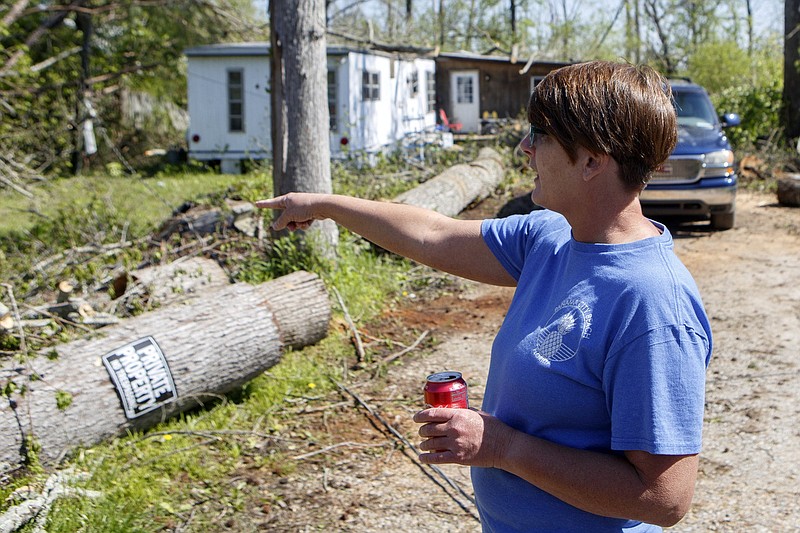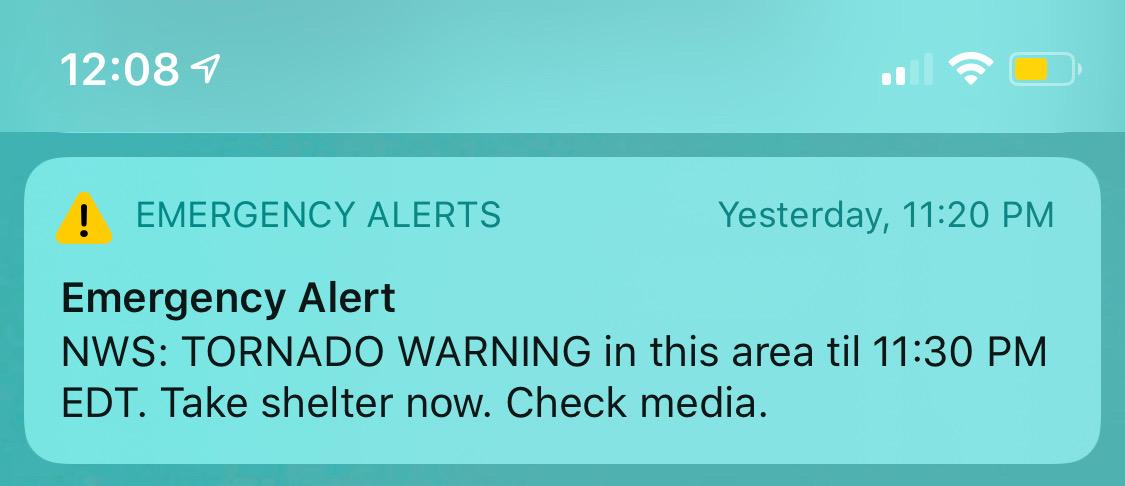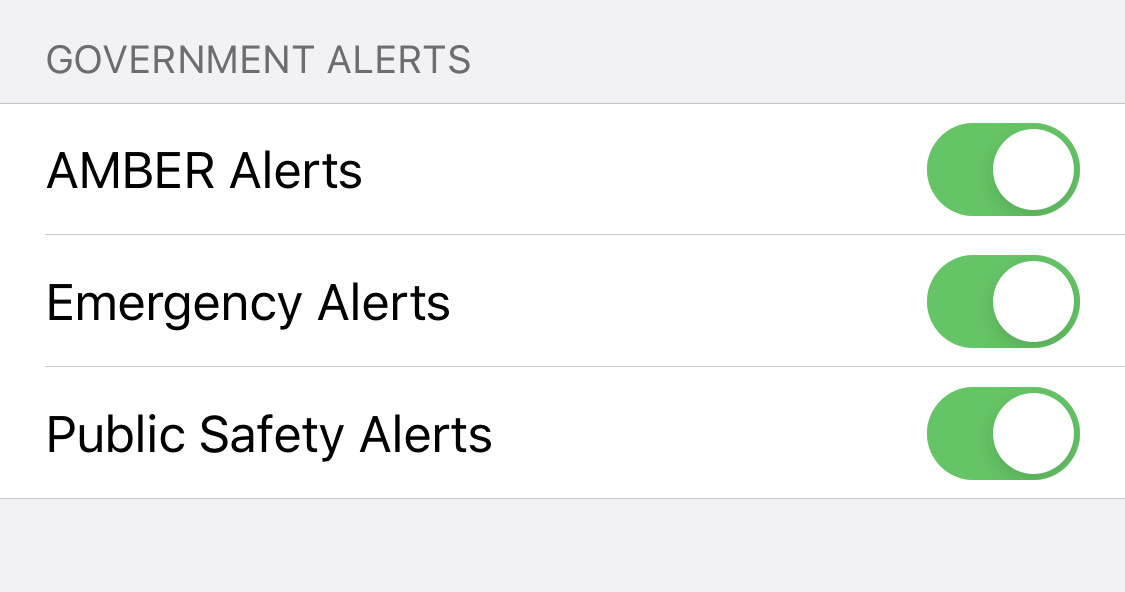An EF3 tornado blew through Hamilton County late on Easter Sunday, demolishing hundreds of structures, killing three people and injuring at least 17 others.
The storm, which produced that tornado and six others in the region, traveled from Louisiana and was visible to meteorologists for days before it hit, and yet many Hamilton County residents did not know about the storm until it was ripping homes apart. Unlike neighboring Bradley County, Hamilton County did not send an alert to its residents about the severe storm hurtling its way.
Standing in her driveway, surrounded by fallen trees that had been hauled off her roof, with one still protruding from the bedroom where it had crashed during the storm, one Ooltewah mother told the Times Free Press Thursday how close she and her family came to harm during the storm.
"We were all at home and my dad called and was begging us to leave and go over to his house but we didn't at first because we didn't think anything was actually going to happen," said Brooke Bridges, who was in her mobile home off of Bill Reed Road with her three kids when the tornado hit.
She was less than a mile from the site where a man died in his mobile home after it was wrecked by trees during the storm.
"We could have been here, and there's a hole in our bedroom where my son would have been lying, and I would have been laying there," she said. "It's just so scary to think that we would have been in there if he hadn't called."
Like the neighbors she's spoken to and most of Hamilton County, there was no siren and no alert telling Bridges about the storm.
(READ MORE: Why Hamilton County says it did not send any alerts before Sunday's deadly tornado)
Three days' notice
As the storm traveled around 45-50 miles per hour toward the Tennessee Valley, the National Weather Service was able to warn local television stations nearly three days before the tornadoes that there would be severe thunderstorms, possible flooding and tornadoes in the Chattanooga area late that Sunday night.
"I had conference calls with all the TV stations and our emergency managers on Friday afternoon in the southern portion of the state," Anthony Cavallucci, a warning coordination meteorologist for the National Weather Service's office in Morristown, Tennessee. "There was definitely enough notice to give the public warning."
While television news stations tracked the storm throughout the weekend, giving many residents notice, no blanket notice was pushed by the county to alert citizens of the storm, posing a problem for those who do not watch or have access to television news.
"We didn't ever get any kind of alert saying there was anything coming our way, so of course we didn't just sit around and watch the news to scare my 6-year-old," Bridges said. "Every time they say there's going to be a tornado, I just blow it off because the few times I have gone somewhere, it wound up being nothing."
Cavallucci, who first notified television stations of the storm around 5 a.m. Friday, said there was ample notice for citizens to prepare for storms.
Meteorologists are right most of the time, he said.
"Once it was out there and we're all touting a message of potential severe weather, why didn't you believe it if you heard it? That's beyond me," he said.
Up the road in Bradley County, where four tornadoes struck that same night, citizens were sent seven notifications by Bradley County Emergency Management.
"When it started hitting Chattanooga we started sending warnings and it took it about 15 more minutes to get here," Curtis Cline, an administrative officer for Bradley County said. "We didn't wait for the National Weather service, we sent our alert first."
Using NIXLE, a law enforcement alert tool, Bradley sent its first warning at 11:46 p.m. Sunday, and the storm hit around midnight, according to Cline. Three more warnings were pushed to county residents between 12-12:30 a.m. Monday as the tornadoes continued.
Each alert went to 28,582 residents via cell phone, 5,000 by email and "who knows how many" via social media as each alert is automatically posted, according to Cline.
In Hamilton County, emergency management sent zero alerts to citizens.
'Personal responsibility'
While an alert was sent from the National Weather Service - the kind you see scroll across the bottom of a screen or hear after tones on the radio - earlier in the evening, relatively few residents in Hamilton County actually received notice of the storm directly to their phones as the storm arrived.
According to Cavallucci, a push notification was sent by the weather service around 11:16 p.m., less than two minutes before the tornado touched down in Hamilton County, but even that late notification only went to a specific group of cell phone owners.
"Our phone alerts go to people with smart phones, like three years or newer or something like that, that fall within the polygon of the storm and have a setting on their phone allowing this kind of messaging turned on," Cavallucci said. "The other alerts that you see more people get are done through [integrated emergency messaging] through the county."
So if you were in Hamilton County on Sunday night outside of the projected storm path, without the right smartphone or without the right settings turned on, you got no alert, heard no siren, and potentially had no idea there was a tornado in your area.
While some parts of Tennessee and Georgia use tornado sirens, Hamilton County does not, citing topography, a local nuclear plant and the expense.
"Our office has looked at other means of notification such as sirens. We do live with nuclear sirens in our area covering 10 square miles of the emergency planning zone area of Sequoyah Nuclear Plant," Hamilton County Emergency Management Communications Director Amy Maxwell said Friday. "Research has shown sirens are for outside notification. With our terrain being hills and valleys [that] reduces the distance they can be heard even if you are outside."
Officials said earlier in the week that using the sirens for multiple purposes could be confusing to residents. In the case of a radiological event at the nuclear plant, residents are told to leave the area when they hear sirens, while in the event of a tornado residents are told to shelter in place.
Maxwell added that the cost of sirens has also deterred the county from implementing a new system.
"The cost was $200 million and $2 million a year to maintain over our 576 square miles," she wrote in an email. "The taxpayers would have a significant tax burden to support a system that would be of little use. When we get storms in our area, we are all usually inside. I cannot hear the Sequoyah sirens from inside my house now. With our topography, it is not like Georgia or Middle Tennessee. It is not flat, and weather experts cannot see it coming as easily as these other areas."
Asked why the county didn't send a phone notification of the storm, Maxwell said the existing integrated alert system had irritated some citizens before during tests.
"We don't use the integrated emergency messages much. We used to use those test messages once a month, but people were getting them at very early hours of the morning because, unless you have Verizon, many cellphones just don't get them for sometimes one or 12 hours later," Maxwell told the Times Free Press Tuesday. "And then the problem with this storm is that we had two or three minutes once this storm had a tornado, so towers were torn down before we could have issued an alert."
Maxwell did say, despite the unpopularity with citizens, the county would have "definitely" still sent alerts had it had ample notice of the tornado, but that the tornado was moving too quickly to notify residents once the National Weather Service alert came out.
But ultimately, Maxwell says, there's an element of personal responsibility being overlooked.
"Remember, we all leave our families at home alone to come in to the Emergency Operations Center to try and make a difference while knowing a storm is coming. They get the same notifications as the rest of our county," Maxwell wrote in an email Friday, touting the office's supply donation and clean-up efforts after the storm. "It is always on our minds our family could be killed and we survive at work All of us have the responsibility to protect ourselves during an emergency situation."
"If you live in an unstable location, like a mobile home, you need to have a plan to have somewhere [safe to go] well ahead of there actually being a storm," Maxwell said Tuesday. "People are responsible, especially if they live somewhere unsafe, for having a plan in case of this kind of emergency."
Maxwell and Cavallucci both stressed that citizens should own emergency weather radios, which typically cost between $30 and $60 online, monitor television broadcasts and download weather apps to ensure notification of storms.
"There are some tools you can have and a lot you can do to prepare outside of waiting on a certain alert," Cavallucci said. "I'll tell you this, by the time our alert went out at 11:16, some people had less than a minute before the storm hit, so what good would that really do?"
Tips on downloading weather apps:
* The National Weather Service and the National Oceanic and Atmospheric Administration do not make weather apps.* Red Cross and/or FEMA apps are reliable for tornado warnings.* If you pick a commercial app — which might have more bells and whistles — avoid those with a NOAA or NWS logo as they are not actually run by either service.* A weather radio is a good resource, too.Source: Anthony Cavallucci, National Weather Service warning coordination meteorologist
While Bridges said she would "absolutely" take television and other warnings more seriously in future storms, she said she wishes there had been something clearer to go off of Sunday.
"I will absolutely be quicker about responding," she said. "I do think we should know what it is we're looking for and know when it is that a warning is actually serious and make sure that everyone is getting the same information, though."
In her statement Friday, Maxwell did not address Times Free Press questions about whether the county should have handled the storm differently or if the process will be changed.
Contact Sarah Grace Taylor at staylor@timesfreepress.com or 423-757-6416. Follow her on Twitter @_sarahgtaylor.



